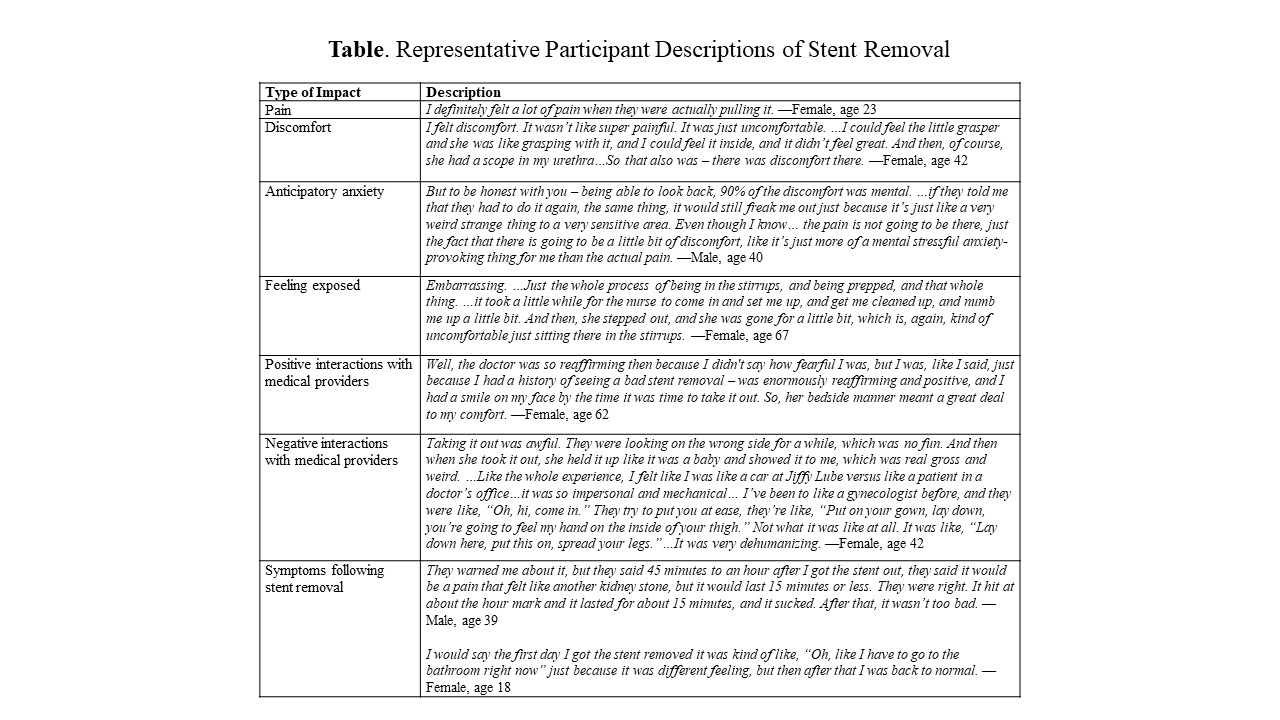Back
Poster, Podium & Video Sessions
Podium
PD50: Stone Disease: Epidemiology & Evaluation II
PD50-11: The Patient Voice: Experiences with Ureteral Stent Removal – A Urinary Stone Disease Research Network (USDRN) Study
Sunday, May 15, 2022
5:10 PM – 5:20 PM
Location: Room 255
Carrie Dombeck, Charles Scales Jr*, Kevin McKenna, Teresa Swezey, Durham, NC, Jodi Antonelli, Dallas, TX, Alana Desai, St. Louis, MO, Jonathan Harper, Michele Curatolo, Seattle, WA, Naim Maalouf, Dallas, TX, Peter Reese, Rebecca McCune, Philadelphia, PA, Hussein Al-Khalidi, Durham, NC, Ziya Kirkali, Bethesda, MD, Amy Corneli, Durham, NC

Charles Douglas Scales, Jr., MD, FACS, MS
Duke University School of Medicine
Podium Presenter(s)
Introduction: Ureteral stents are often employed after ureteroscopy, and subsequently require removal. Despite this requirement, to date, no studies have qualitatively described patients’ experiences with removing indwelling ureteral stents following ureteroscopy for stone disease. The objective of this study was to describe the qualitative experiences of patients undergoing ureteral stent removal.
Methods: The USDRN Study to Enhance Understanding of Stent-Associated Symptoms (STENTS) is a prospective observational cohort study that included a nested cohort of participants who completed qualitative in-depth interviews (n=38) within 30 days after stent removal. Participants were asked to reflect on (1) painful or bothersome aspects of stent removal (2) symptoms immediately after removal, and (3) symptoms in the days after removal. All interviews were audio-recorded, transcribed, and analyzed using a rigorous qualitative method (applied thematic analysis).
Results: Of the 38 participants, 21 (55%) were female, with ages ranging from 13 to 77 years. Interviews were conducted 7–30 days (median = 16 days) after stent removal. Almost all participants (n=31) reported experiencing either pain or discomfort at some point during stent removal, but this was of short duration for most. Many (n=21) also described anticipatory anxiety related to the procedure, and several (n=11) discussed discomfort arising from lack of privacy, embarrassment, or feeling exposed (Table). Interactions with medical providers had the potential to ease patient concerns, or conversely, to increase discomfort. Following stent removal, several participants (n=18) described persistence of pain and/or urinary symptoms, but for most, these largely resolved within 24 hours. Only a few reported lingering symptoms more than a day after stent removal.
Conclusions: Our findings expand the understanding of patient experiences during and shortly after ureteral stent removal, and importantly, identify opportunities for improvement. Patients experience psychological distress related to stent removal, which has not been described previously. Optimal communication before and during the removal procedure, and about the possibility of delayed pain, may improve patient experience.
Source of Funding: NIH/NIDDK

Methods: The USDRN Study to Enhance Understanding of Stent-Associated Symptoms (STENTS) is a prospective observational cohort study that included a nested cohort of participants who completed qualitative in-depth interviews (n=38) within 30 days after stent removal. Participants were asked to reflect on (1) painful or bothersome aspects of stent removal (2) symptoms immediately after removal, and (3) symptoms in the days after removal. All interviews were audio-recorded, transcribed, and analyzed using a rigorous qualitative method (applied thematic analysis).
Results: Of the 38 participants, 21 (55%) were female, with ages ranging from 13 to 77 years. Interviews were conducted 7–30 days (median = 16 days) after stent removal. Almost all participants (n=31) reported experiencing either pain or discomfort at some point during stent removal, but this was of short duration for most. Many (n=21) also described anticipatory anxiety related to the procedure, and several (n=11) discussed discomfort arising from lack of privacy, embarrassment, or feeling exposed (Table). Interactions with medical providers had the potential to ease patient concerns, or conversely, to increase discomfort. Following stent removal, several participants (n=18) described persistence of pain and/or urinary symptoms, but for most, these largely resolved within 24 hours. Only a few reported lingering symptoms more than a day after stent removal.
Conclusions: Our findings expand the understanding of patient experiences during and shortly after ureteral stent removal, and importantly, identify opportunities for improvement. Patients experience psychological distress related to stent removal, which has not been described previously. Optimal communication before and during the removal procedure, and about the possibility of delayed pain, may improve patient experience.
Source of Funding: NIH/NIDDK


.jpg)
.jpg)